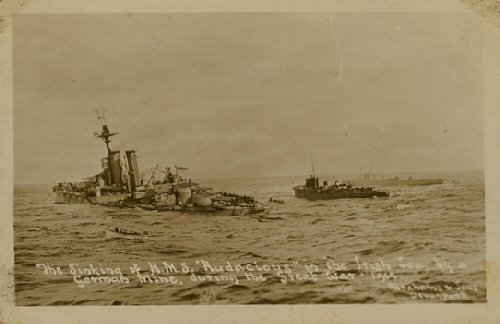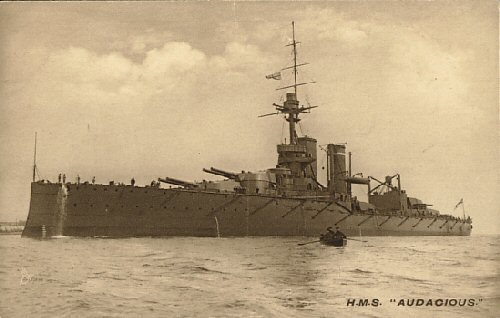
Mined and sunk 27 October 1914
HMS Audacious was built by Cammell Laird, laid down March 1911, completed August 1913, at a cost of £1,918,813
Size:
Length 589 feet 6 inches waterline 597 feet 9 inches overall, beam 89 feet 1 inches, draught 28 feet 8 inches, displacement 25,420 tons load 27,120 tons deep.
Propulsion:
4 shaft Parsons turbines, 27,000 shp, 21kts.
Armour:
12-8in belt, 10-3in barbettes, 11in turret faces, 4-1in decks
Armament:
10 x 13.5in 45cal MK V (5 x 2), 16 x 4in (16 x 1), 4 x 3 pounder (4 x 1), 3 x 21in TT
In August 1914 the German liner Berlin was taken in hand for conversion to an auxiliary mine-layer. Towards the end of September she set off from Wilhelmshaven on her first mission but turned back after spotting some British warships. On October 16 Berlin set off again on another mission, this time to lay mines in the Firth of Clyde.
Berlin made her way to the Irish Sea but a combination of extinguished coastal lights, used for navigation, and a large amount of British warship wireless traffic convinced Captain Pfundheller that he would be unable to reach his target area. Instead he decided to lay his mines in the nearest shipping lane, which was near Tory Island and Loch Swilly on the north coast of Ireland. Berlin laid her 200 mines in a V shape and then left the area, heading for Norway via Iceland, fuel and machinery problems forcing Berlin to seek internment in Trondheim, Norway, on 26 October.
Unknown to the German command the British The Grand Fleet was using Loch Swilly as a base whilst the main base at Scapa Flow in the Orkney Islands was having its feeble defences against submarine attack improved. On 27 October 1914 Vice Admiral Warrender took the Second Battle Squadron, consisting of the "super-dreadnoughts" Centurion (flagship), Ajax, Audacious, King George V, Orion, Monarch and Thunderer, out of port on a gunnery exercise.
At approximately 08.45, as Audacious was turning a dull thud was heard on board, but at first it was not clear that it was an explosion. When the ship stopped turning but did not right herself correctly, the order to close watertight doors was given. The mine had struck on her port side just forward of the after engine room bulkhead. To counter the flooding some starboard side compartments were flooded but the ship still developed a 10-15 degree list. Captain Dampier set course for Loch Swilly at the best manageable speed of 9 knots but steering was hard.
The flooding was spreading, the central bulkhead which at first had contained the flooding was leaking and water was spreading into the ships central compartments, and by 10.00 the central engine room was 5 foot deep in water. Shortly after this the starboard engine room had to be abandoned leaving the dead in the water and eventually without any steam power for auxiliary machinery.
All but 250 essential crew were evacuated via the White Star liner SS Olympic, the light cruiser HMS Liverpool and destroyers and the decision to attempt to tow the crippled ship taken. At 14.00 SS Olympic made an attempt to tow but the Audacious was pulling to the west and the SS Olympic to the south resulting in the tow line parting. Attempts to tow were also made by HMS Liverpool and the collier Thornhill but on both occasions the attempt failed.
By 17.00 it was getting dark and soon after all but the last 50 crew were removed and at 18.15 the she was abandoned. For most of the day Audacious had not increased her list but was sinking by the stern, however at 18.50 her list was seen to reach 30 degrees and at 20.45 she capsized. Quarter of an hour later there was a large explosion, thought to be either A or B magazine, followed by two secondary explosions and HMS Audacious finally sank.
Although thankfully no lives had been lost the sinking of Audacious was a serious blow to the British Fleet. At the time several other British battleships were suffering from engine problems and several others were so new that they were not fully efficient yet. This meant that the British Fleet was much weaker in reality than on paper and the Grand Fleet Commander-in-Chief Admiral Sir John Jellicoe proposed that the loss was kept secret. This request was backed by the British Foreign Office who were keen to avoid the bad publicity for diplomatic reasons whilst trying to influence the then neutral Ottoman Empire and the request was agreed by the British cabinet. The loss of Audacious was not admitted until after the war and Audacious continued to appear in fleet lists. This censorship turned out to be a waste of time because on board SS Olympic had been many Americans who had witnessed and photographed much of the incident. When back in America and outside the reach of British censorship the loss was soon reported in the press. Soon everyone except the British acknowledged the loss and the continued British silence on the subject did the creditability of the British authorities damage.
At the time it was thought that Audacious had hit a floating mine disturbed by either Ajax or Centurion although a torpedo attack was not completely ruled out. The inquiry also found that the main reason for the loss was lack of strength in the longitudinal bulkheads which should have prevented flooding spreading. This resulting in the bulkhead buckling and making it impossible to close some of the watertight doors and valves that were necessary to stop the water spreading.
